Where Is Japan? Is it even possible for people not to know this? Why even bring it up or let alone write an entire article about it? Even though approximately 2/3rds of American youths couldn't find Iraq on a map and 88% couldn't find Afghanistan in 2006 (not to mention 33% couldn't find the state of Louisiana despite being Americans) you'd think the people of the world, even Americans, could find Japan on a map. Right? Right? Wrong.

I like to see what people are searching for on Google sometimes. I put in "Japan" as a keyword, and asked Google to tell me related terms. I was surprised to find that 68 million people per month are searching for the term "where is Japan" with 13,600,000 of those searches coming from America. Whew, I guess we only make up 20% of the world's geographically challenged population.
But, I can't just write about where Japan is. That would be silly. You can find the answer to that easily (or, you can just look at this map. See giant red arrow).

Hopefully you can find a country you do know to figure out where Japan is in relation But that's not the whole story. There's more to it than just this. Japan isn't just there… it's a little more complicated than that. We can't just ask "Where Is Japan?" and get away with a shoddy map with a big red arrow. Let's dive deeper.
Where Is Japan: Contested Islands Version
Japan isn't particularly friendly with its geographical neighbors. It's not an all-out-brawl, but nobody's getting invited over for Sunday Night Bridge. There are a number of islands near and around Japan that Japan thinks they own. At the same time, other countries think that they own them. So who owns them? I'm not sure, but they're kind-of-sort-of Japanese islands, so you have to at least think about them when you ask the questions "Where Is Japan."
Kuril Islands
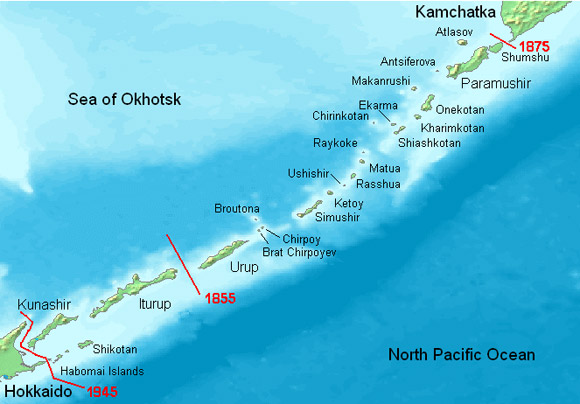
The Kuril Islands are the islands to the North of Japan which (supposedly) are part of Hokkaido. Russia, on the other hand, doesn't think this is part of Japan. Why the dispute? After World War II during the San Francisco Peace Treaty, Japan was told to give up all claims to the Kuril Islands. Japan, on the other hand, doesn't accept this because in 1855 during the Treaty of Shimoda borders were created during this first diplomatic relations with the Soviet Union where it was agreed that the border would be between Urup and Iturup. On top of that, in 1875, Russia traded all the islands in exchange for Sakhalin, which is this big red island. Pretty good deal, I'd say.
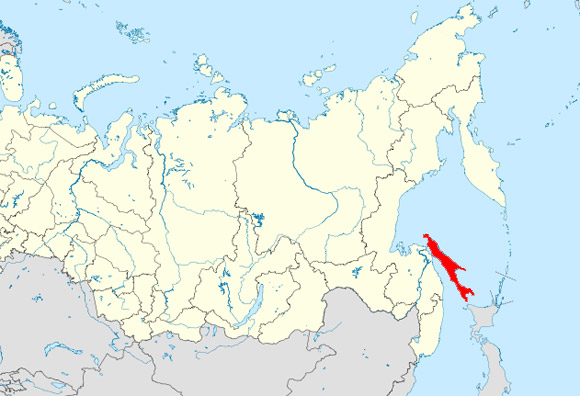
Even later in 1905 (right after the Russo-Japanese war), Japan got the southern half of Sakhalin back (someone's getting island greedy). So, besides Sakhalin, they sort of have decent claim on at least some of these islands, I'd say.
Lots has gone on lately with the Kuril Islands, too. The European Parliament recommended Russia return the Islands to Japan in 2005 (though Russia wasn't about to do that). Later, Putin offered to return Shikotan and Habomai to Japan if they could have the other two, but these two islands only consisted of 6% of the area. Japan retaliated (very nicely) by offering financial aid to the islands if they were given back, but this didn't work because the economy was getting better around there (we don't need your dirty yen, Japan). Japan later went so far as to add these islands into textbooks for school kids showing them as part of Japan.
It's not all bad, though. There's been lots of talks about it and Russia has even made it so Japan can visit the islands visa-free and Japanese fishermen can fish there. Still though, Russia has been building up military defenses on the island, including amphibious assault ships and anti-air missile systems.
Really, though, I'd say the Kuril Islands are pretty tame compared to some of the other island disputes. It's a lot less of a crybaby battle and a lot more diplomatic, not like the next two islands.
You can find more info on the Kuril Islands here.
Diaoyutai/Senkaku Islands
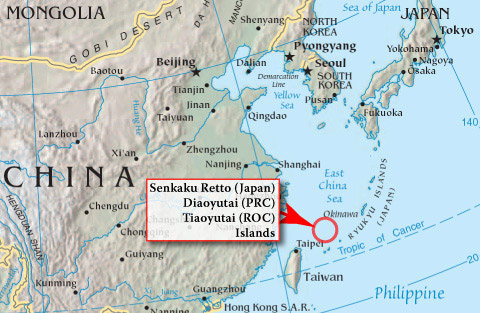
The Diaoyutai/Senkaku Islands dispute is a little bit more interesting, I think. These islands are east of China, North East of Taiwan, and South West of Okinawa (and Island that is part of Japan). What's so interesting about these islands? They're uninhabited. They are pretty though, at least.
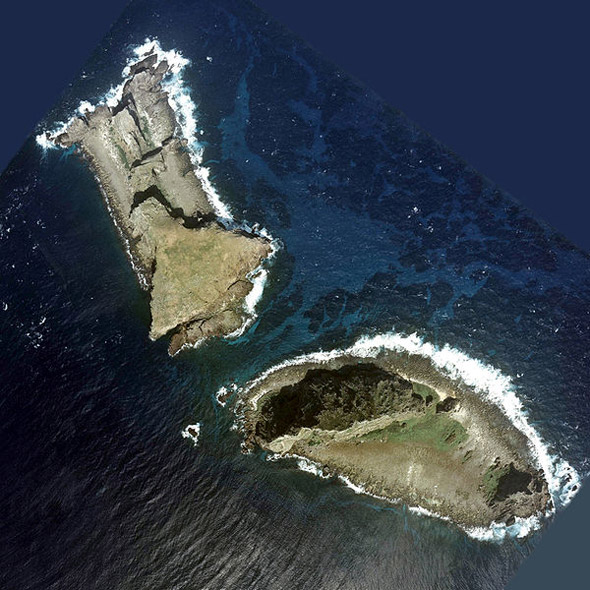
Japan claimed these islands in 1895 and gave them up to the United States after World War II (sensing a theme here?). In 1972, the US gave back the islands (because really, they're kind of worthless as far as islands go) and then China and Taiwan immediately started claiming that they actually owned the islands. China said they discovered the islands in the 14th century, and Taiwan just wants to piss of China anytime they can, so I'm guessing that's why they laid claim (oh, that and they're much closer to the islands compared to both Japan and China).
Still though, in 1900 Japan built a bonito factory on one of the islands, making it more inhabited than its really ever been in modern history. Although this delicious bonito stopped getting manufactured in 1940 and the islands got deserted, I'd say this is a pretty decent claim. Overall if I were the God of Undisputing Islands, I'd give it to Taiwan. They're 76 nautical miles away from the island, compared to Okinawa (220 nautical miles) and China (pretty far away).
This set of islands, though, is really just a case of national pride getting in the way of reason. Unless there's some hidden resources or special use for these islands, that's the only other explanation I can think of. This gets worse in the next disputed island.
Takeshima Island / Dokdo
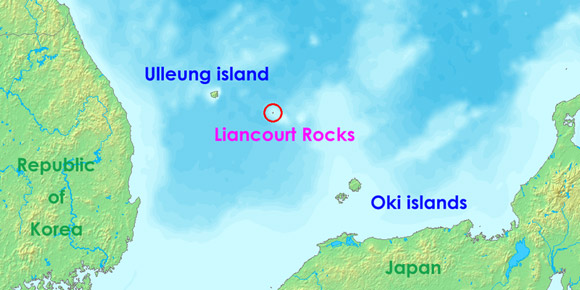
The Takeshima Islands / Dokdo Islands (Korean), also known as Liancourt Rocks (because it consists of a few rocks) that are disputed by both Japan and Korea (you can see it's between the two nations in the East Sea / Sea of Japan). As you can see from the picture below, there are two main ~~rocks~~ islands, and (what you can't see) 35 smaller rocks sticking up around it. There's a light house on the Eastern Island along with two Korean citizens (an octopus fisherman and his wife) along with a small police detachment, administrative personnel, and lighthouse staff (though these are non-permanent residents who probably really, really can't wait to get home).
South Korea thinks these islands are part of the Ulleung Island government. Japan thinks these islands are part of the Oki Islands government. Overall, though, I'd say Korea has a better claim to this one. They have two permanent residents (which is an infinite number more than Japan has), over a thousand tourists who visit (it's a nature reserve), and other non-permanent people on the island as well. Korea agrees with this sentiment as well – apparently on the ferry ride over to the Liancourt Rocks they show an animated film where a "giant Robot Taekwon V figure soars up out of the sea and routs Japanese pirates trying to invade Dokdo." To be fair, the giant robot is protecting a couple of really nice looking rocks.
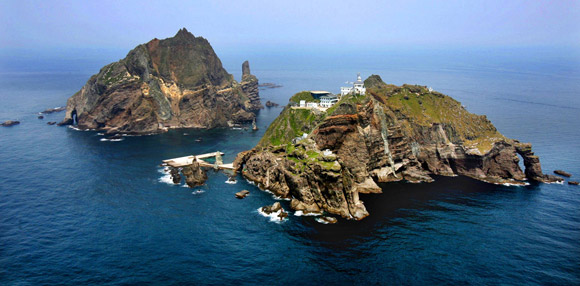
As of right now, there's definitely very little claim that Japan could have on these islands. In recent years, Korea has built the lighthouse, a helicopter pad, a South Korean flag (visible from the sky! Ancient Aliens??), two desalinization plants, cell phone towers, and a police barracks. On top of this, Korea sends students from 62 elementary, middle, and high schools on field trips to the islands (no fair, I only got to go to the landfill / water treatment plants for my crappy field trips). They've made stamps with the islands on them, and wrote a textbook about the islands for kids to learn from.
Still, though, Japan has done things like create a "Takeshima Day" pretty much just to fan the nationalistic fires of the two nations. If I were Japan, I'd stick to focusing on the Kuril Islands – There's more stuff there, anyways.
You can find out more about the ~~Takeshima Island~~ Dokdo Islands here.
So, Where Is Japan, After All?
Well, to be honest, it's pretty much exactly where you thought it was this whole time (assuming you knew where Japan was in this world in the first place). When it comes to the three main disputed islands, though, overall I'd say Japan isn't in any of those locations. The closest they come is the Senkaku Islands, but is it actually worth all the hassle? Maybe, maybe not. Nationalism will do funny things to people, especially considering there's no people on Senkaku.
Still, almost all of these contested situations come from Japan's old rivals from World War II (and before). Not a lot of good history between Korea, China, Russia, Most Of Asia, and Japan. All that's fairly far in the past now, and Japan isn't the same imperialistic territory grabbing country of its past, but people still remember, and lots of prides are at stake, causing most of these disputes.
But, what will you say now when someone asks you "Where is Japan?"
I'd just point on a map, to be honest, and then tell this person to study their geography a little more. All this other stuff is probably way too complicated for them if they can't find Japan in the first place.
